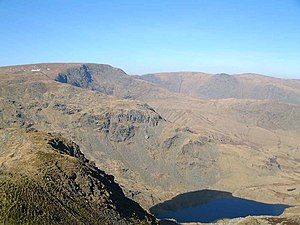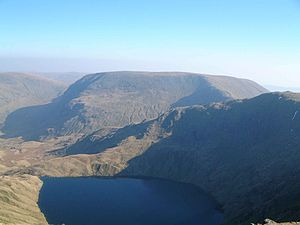High Street: Difference between revisions
mNo edit summary |
No edit summary |
||
| (2 intermediate revisions by 2 users not shown) | |||
| Line 6: | Line 6: | ||
|picture caption=High Street from Harter Fell | |picture caption=High Street from Harter Fell | ||
|height=2,717 feet | |height=2,717 feet | ||
|latitude=54.491228 | |||
|longitude=-2.866021 | |||
|os grid ref=NY440110 | |os grid ref=NY440110 | ||
}} | }} | ||
'''High Street''' is a fell in [[Westmorland]], within the [[Lake District]]. At 2,718 | '''High Street''' is a fell in [[Westmorland]], within the [[Lake District]]. At 2,718 feet, its summit is the highest point in the Far Eastern Fells. The fell is named after the Roman road which ran over the summit. | ||
==History and name== | ==History and name== | ||
| Line 32: | Line 34: | ||
==Outside links== | ==Outside links== | ||
*[http://www.helmcrag.co.uk/high-street-walk/ Illustrated ascent from Mardale with downloadable route] | *[http://www.helmcrag.co.uk/high-street-walk/ Illustrated ascent from Mardale with downloadable route] | ||
* | * [http://www.viewfinderpanoramas.org/panoramas/CUM/Highstreet.gif Computer generated summit panorama] | ||
*[http://www.lakedistrictwalks.net/high-street-walk Lake District Walks - High Street walk] | |||
==References== | ==References== | ||
{{Reflist}} | {{Reflist}} | ||
{{Wainwrights|2}} | |||
Latest revision as of 19:30, 6 June 2017
| High Street | |||
| Westmorland | |||
|---|---|---|---|
 High Street from Harter Fell | |||
| Range: | Lake District Far Eastern Fells | ||
| Summit: | 2,717 feet NY440110 54°29’28"N, 2°51’58"W | ||
High Street is a fell in Westmorland, within the Lake District. At 2,718 feet, its summit is the highest point in the Far Eastern Fells. The fell is named after the Roman road which ran over the summit.
History and name
The Roman road crosses the fell on its journey between the forts at Brougham (Brocavum) near Penrith and at Ambleside (Galava). Situated in one of the quieter areas of the Lakes, the High Street range has quite gentle slopes with a flat summit plateau. It was these characteristics which persuaded Roman surveyors to build their road over the fell tops rather than through the valleys which, at the time, were densely forested and marshy thus making them susceptible to ambushes.
The fell's flat summit was also used as a venue for summer fairs by the local population in the 18th and 19th centuries. People from the surrounding valleys would gather every year on 12 July to return stray sheep to their owners; games and wrestling would also take place as well as horse racing. The summit of High Street is still known as Racecourse Hill and is so named on maps, and fell ponies can be found grazing occasionally on its summit. The last of the these summer fairs was held in 1835.
Geography
Several becks rise on the slopes of High Street and run in every direction; some west to Hayeswater and thence to Ullswater or north directly to Ullswater, some east to Haweswater and the River Lowther, all draining ultimately to the Solway Firth, while others flow south to drain to Morecambe Bay, and amongst these latter streams is the infant River Kent. The Kent flows south through the town of Kendal, and is reputed to be the fastest flowing river in England.
High Street's eastern side is craggy and precipitous as it falls away towards Haweswater Reservoir. There are two tarns underneath the eastern crags — Blea Water and Small Water; Blea Water stands in a classic mountain corrie and at 200 feet is the deepest tarn in the Lake District.[1]
Summit and view
A wall follows the ridge over the flat summit, the highest point marked by an Ordnance Survey trig point. The view stretches from the Pennines in the east to a great arc of Lakeland hills filling the western horizon. The Helvellyn range and Southern Fells are particularly striking.[2]
Ascent
The best ascents of the fell can be undertaken from the east. The climb from Mardale is an exhilarating ridge walk with spectacular views down into Riggindale which may be supplemented by the sight of a Golden Eagle — Riggindale has the only bird of this kind left in Britain outside the Highlands, a solitary male, which has been on its own there since 2004.
High Street can also be climbed from Patterdale, Kentmere and Troutbeck: these are less interesting routes, although the walk from Troutbeck does follow the line of the Roman road. The full south to north traverse of the High Street ridge from Ings near Windermere to the Eamont valley at the northern end of Ullswater is a tough 19 miles hike over twelve summits, and should only be undertaken by experienced walkers.[2][3]

Outside links
- Illustrated ascent from Mardale with downloadable route
- Computer generated summit panorama
- Lake District Walks - High Street walk